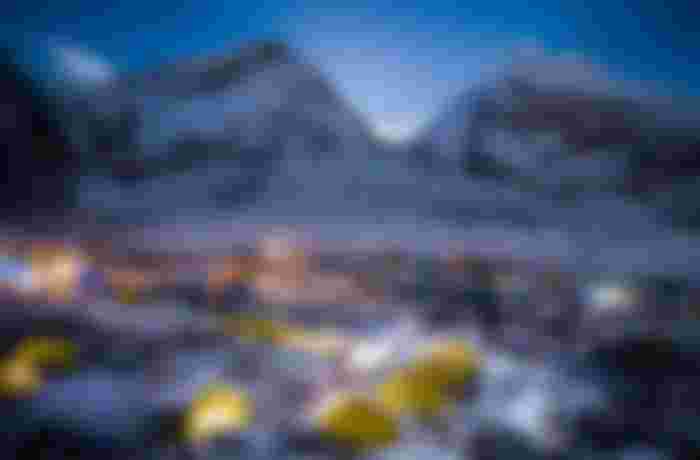
In the years since human beings first reached the summit of Mount Everest in 1953, climbing the world’s highest mountain has changed dramatically. Today, hundreds of mountaineers manage the feat each year thanks to improvements in knowledge, technology, and the significant infrastructure provided by commercially guided expeditions that provide a veritable highway up the mountain for those willing to accept both the risks and a hefty price tag.
Where is Everest?
Mount Everest—known in Nepali as Sagarmatha and Tibetan as Chomolungma—straddles the border between Nepal and Tibet at the crest of the Himalayan mountain chain. Although reaching the top of the world is an arduous and potentially deadly undertaking due to the extreme altitude, avalanches, icefalls, and other hazards, the mountain lies quite close to the equator, at a latitude of approximately 28 degrees, the same as Tampa, Florida.

Everest hasn’t stopped growing
Earth scientists estimate that Everest is 50 to 60 million years old, a youngster by geological standards. The mountain was formed by the upward force generated when the Indian and Eurasian tectonic plates collided, pushing up the rocks that formed the highest mountain on Earth. That force is still at work today, pushing Everest’s summit about a quarter of an inch higher each year.
At 29,035 feet, Everest’s summit has approximately one-third the air pressure that exists at sea level, which significantly reduces a climber's ability to breathe in enough oxygen. Because of this, scientists have determined that the human body is not capable of remaining indefinitely above 19,000 feet. As climbers move higher up the mountain and their oxygen intake is reduced, their bodies are increasingly at risk for a number of ailments, including pulmonary edema, cerebral edema, and blood embolisms. The chances of frostbite are also dramatically increased at such altitude as the heart works harder to pump blood around the body delivering oxygen. The life-giving organs are first priority; digits are last.

The vast majority of climbers ascending Everest use tanks of oxygen to reduce the effects of the extreme altitude. However, bottled oxygen has its own drawbacks and risks. For starters, it’s expensive, heavy to carry, and empty cylinders are frequently abandoned as litter. Furthermore, breathing “gas” only increases the relative oxygen to about the same level as the air at basecamp, and if it runs out on summit day, the body might not be able adapt to the sudden lack of oxygen. Lastly, oxygen units are notoriously unreliable, as Everest guide Adrian Ballinger discovered in 2018 on summit day when his team experienced a systematic failure of their breathing systems.
How many routes to the top?
Although 17 different routes have been pioneered to the summit of Everest, almost everyone climbs it via one of two routes. From Nepal there’s the Southeast Ridge, the line created by Tenzing Norgay and Edmund Hilary in 1953. From Tibet, there’s the North Ridge, where George Mallory disappeared in 1924 long before a Chinese team finally completed the climb in 1960.

Although experienced mountaineers say the overall difficulty of the two routes is comparable, the challenges are different. On the Southeast Ridge, mountaineers must race through the hazardous Khumbu Icefall, but it’s a slightly shorter summit day and easier to descend quickly in the event of an emergency. On the North Ridge, it’s possible to drive jeeps all the way to base camp, but mountaineers must traverse several kilometers of terrain above 27,000 feet to reach the summit. [Read about China's highway to Everest]
[bad iframe src]
How crowded is Everest?
Mount Everest’s popularity soared in the 1990s when international guides began to pioneer commercial trips up the mountain. Despite the risks, Everest draws hundreds of mountaineers from around the world to its slopes each year. In 2018 the Nepal Ministry of Tourism issued 347 individual climbing permits to foreign climbers, and reports that 261 of them summited, along with 302 high-altitude workers. On the North side of the mountain, meanwhile, respected Everest chronicler Alan Arnette estimates that an additional 239 people reached the summited.

A big business built around a tough job
For local logistics companies and the Government of Nepal, Everest is big business. A typical spot on a commercial team costs anywhere from $40,000 to $100,000 depending on the level of service and the expertise of the outfitter. The Ministry of Tourism reported collecting $5.2 million in 2018 permit fees.
[bad iframe src]
The industry is built on the backs of a small cadre of professional Nepalese guides who work together each spring to prepare the route with fixed ropes and ladders, stock each camp with essentials like tents, stoves, bottled oxygen, and food, and then patiently coach their foreign guests up to the summit. Although historically it was the Sherpas—the Tibetan tribe of people who live closest to the mountain—who were hired by expeditions to carry loads of supplies up the mountain, today there are multiple ethnic groups who find employment on the mountain, leading to the less-catchy moniker of “high-altitude mountain worker.” For a typical three-to-four-month Everest expedition, most earn between $2,500 and $5,000. In recent years, thanks to educational opportunities like the Khumbu Climbing Center, Nepalese guides have begun to receive training and certifications to international standards.
SHE SUMMITED EVEREST. NOW, SHE'S INSPIRING OTHERS TO EXPLORE.Tine Mena is the first woman from North East India to summit Mount Everest. Now, Mena shares her knowledge of the outdoors with her community with the hope that it will inspire them to explore the world around them in this short by Tushar Joneja. The Short Film Showcase spotlights exceptional short videos created by filmmakers from around the web and selected by National Geographic editors. The filmmakers created the content presented, and the opinions expressed are their own, not those of National Geographic Partners.
How long is an expedition?
The best weather for reaching the top of Everest typically arrives in the second half of May, but preparations for a successful ascent begin months beforehand. Most teams assemble in Kathmandu in late March to begin acclimatization. As they trek toward basecamp, their basecamp support staff and high-altitude workers are already on the mountain, carrying loads and preparing the route to the summit. In April, climbers make several overnight forays (“rotations” in Everest parlance) to successively higher camps up the mountain to acclimatize, while the first teams of Nepalese guides reach the summit. By the second week in May, teams hope to have an established trail of several miles of fixed ropes leading from basecamp to the summit, with several well-stocked camps along the way.
After a final rest—some teams will even decamp the mountain entirely to spend a few nights at lower elevation for maximum recovery—the summit push normally takes place over an arduous four to five days’ round trip from basecamp. If all goes well, most Everest climbers are done with the mountain and on their way home by the beginning of June.
How dangerous is it?
As of the end of the 2018 season, the Himalayan Database reports that 295 people are known to have died climbing Everest, while there have been 9,159 successful summit climbs by 5,294 people. The overall death rate—the number of fatalities divided by the overall number of people on the mountain, not just those who summit—is approximately 1.2 percent, meaning that if you try to climb Everest, you have about a one in a hundred chance of dying along the way.
“Statistically, Everest is becoming safer primarily due to better gear, weather forecasting, and more people climbing with commercial operations,” says Alan Arnette. “From 1923 to 1999: 170 people died on Everest with 1,169 summits or 14.5 percent. But the deaths drastically declined from 200.
BREATHTAKING LOOK AT THE MAN WHO CLIMBED EVEREST 21 TIMESEvery spring, Mount Everest draws in people from around the world to conquer its peak. After summiting Everest 21 times, Apa Sherpa is on a mission to build a brighter future for the children of Nepal in this film by Sherpas Cinema. The Short Film Showcase spotlights exceptional short videos created by filmmakers from around the web and selected by National Geographic editors. The filmmakers created the content presented, and the opinions expressed are their own, not those of National Geographic Partners.
What’s the summit like?
The actual summit of the mountain is a small dome of snow about the size of a dining room table. There’s room for a half dozen or so climbers to stand and enjoy the view, although on busy days mountaineers must take turns to truly stand on top of the world.
Is there anything left to explore on Everest?
The last new route to be climbed on the mountain was accomplished by a team of hearty Russians in 2004. While each of Everest’s three major faces and ridges have been ascended, there are several intriguing challenges for future mountaineers to attempt, including the unclimbed Fantasy Ridge and the so-called Horseshoe Traverse, an audacious enchainment of Everest and its two neighboring peaks, Lhotse and Nuptse.

“Everest is in many ways still a blank canvas,” says alpinist and National Geographic photographer Cory Richards. “It’s still as high, cold, and formidable as it ever was. How one chooses to climb it is as much a reflection of creativity as skill. There is always a new way to approach something, and Everest is no different.” Richards will be returning to the mountain in the spring of 2019, where he hopes to find his own first ascent to the world’s highest summit






I'm scared of height